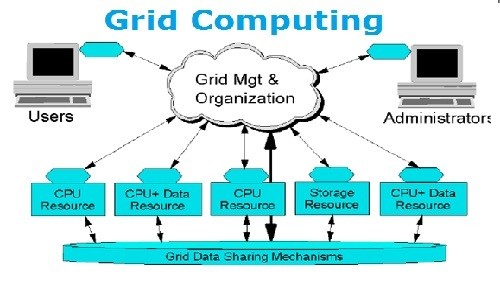Grid Computing
What is Grid Computing?
Grid computing is a type of data management and computer infrastructure, designed as a support primarily for scientific research, but, as said in the introduction, also used in various commercial concepts, business research, entertainment and finally by governments of different countries.
On its simplest level, the grid computing concept integrates four components: information, computation, networking and communication. When these components are connected into the grid, the result is a virtual platform which allows an advanced data and computation management.
If this concept is implemented into the areas mentioned above (science, etc.), it provides a platform where resources can be dynamically linked together, while these resources are then used to support the execution of applications that require significant amounts of computer resources.
Who can use grid computing
Scientists use grid computing for their research. But what about you? And who else might be interested? Who wants to invest time and money in "resource sharing"? Governments and International Organizations? Problems like disaster response, urban planning and economic modeling are traditionally assigned to national governments or coordinated by International Organizations like the United Nations or the World Bank. Imagine if these groups could apply the collective power of the nation's fastest computers and share their data archives more simply and effectively...
The military? It's a pretty safe bet that the military in many countries is already developing grid technology. The United States have traditionally used their most powerful computers for military applications. But this Virtual Organization is unlikely to let other users access its grid! Teachers and educators? Education involves students, teachers, mentors, parents and administrators and so is a very natural application of grid technologies. E-libraries and e-learning centers are already benefiting from grid-based tools for accessing distributed data and creating virtual classrooms with distributed students, resources and tutors.

Businesses? Global enterprises and large corporations have sites, data, people and resources distributed all over the world. Grids will allow such organizations to carry out large-scale modeling or computing by simultaneously using the resources at their many sites.
Grid Computing Applications
One of the most tantalizing applications of radio astronomy is the observation of radio signals as part of Searches for Extra Terrestrial Intelligence (SETI). The first SETI project in the late 1950’s used a radio astronomy dish. Some years later the SETI Institute, a privately-funded organization, was formed to pursue more extensive searches using various radio telescopes in the U.S. The SETI Institute is now building its own array, again with private funds but in close collaboration with radio astronomy engineers and researchers at many observatories and universities.
The vast amount of computing capacity required for SETI radio signal processing has led to a unique grid computing concept that has now been expanded to many applications. SETI@home is a scientific experiment that uses Internet-connected computers to download and analyze radio telescope data for the SETI program. A free computer software program harnesses the power of millions of personal computers, and runs in the background using idle computer capacity. More than 5.2 million participants have logged over 2 million years of aggregate computing time.
Grid computing is now being used for other applications that include biology, medicine, earth sciences, physics, astronomy, chemistry, and mathematics. The Berkeley Open Infrastructure for Network Computing (BOINC) is free, open-source software for volunteer computing and desktop grid computing. Running the BOINC platform allows users to divide work among multiple grid computing projects, choosing to give only a percentage of CPU time to each.
grid-computing-8954-NZWGz1S.docx (48 KB)
grid-computing-8954-nyHfUzl.pptx (433 KB)

